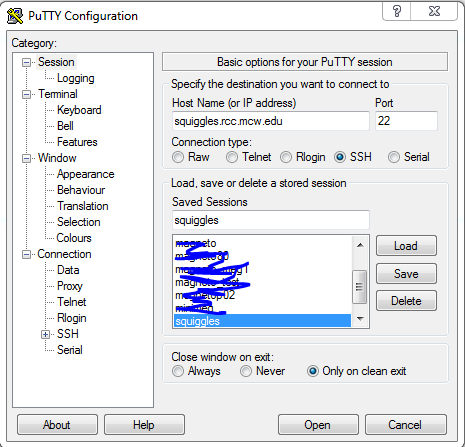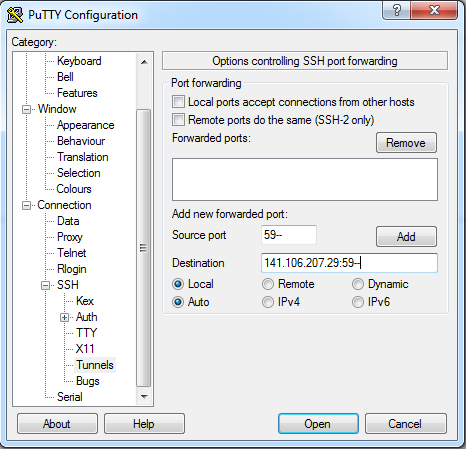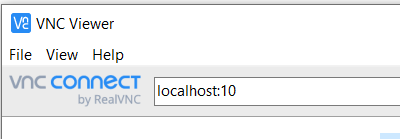SQUIGGLES Computer Login: Difference between revisions
m (Jeff moved page SQUIGGLES COMPUTER to SQUIGGLES Computer Login) |
No edit summary |
||
| Line 4: | Line 4: | ||
For Windows | For Windows | ||
For Mac/Linux | For Mac/Linux | ||
==FastX Connection:== | |||
SECTION UNDER CONSTRUCTION | |||
FastX is an alternative to VNC connections. This provides a more straightforward connection than VNC. Also we have had some issues with the large number of users logging in at once with VNC. | |||
The FastX server is installed on squiggles. You will need to download the client - https://www.starnet.com/fastx/ (I am currently unsure if we have a university download or if you need to start a trial ---UPDATE) | |||
Open the FastX software --- image | |||
Click connect ---image | |||
Enter either gnome-session or /etc/X11/xinit/xinitrc (<< this is the style used with VNC) | |||
==User Ports:== | ==User Ports:== | ||
Revision as of 15:28, 26 June 2019
Squiggles is general purpose analysis and storage computer for MEG/Neurophysiology/Epilepsy data
Configuration: For Windows For Mac/Linux
FastX Connection:
SECTION UNDER CONSTRUCTION FastX is an alternative to VNC connections. This provides a more straightforward connection than VNC. Also we have had some issues with the large number of users logging in at once with VNC.
The FastX server is installed on squiggles. You will need to download the client - https://www.starnet.com/fastx/ (I am currently unsure if we have a university download or if you need to start a trial ---UPDATE)
Open the FastX software --- image
Click connect ---image
Enter either gnome-session or /etc/X11/xinit/xinitrc (<< this is the style used with VNC)
User Ports:
(make sure to log in under your port number)
| User | Port |
|---|---|
| Jeff Stout | 5910,5911 |
| Joe Heffernan | 5912 |
| Candida Ustine | 5914 |
| Manoj Raghavan | 5913 |
| Chad Carlson | 5915 |
| Chris Anderson | 5916 |
| Serena Thompson | 5917 |
| Patrick Bauer | 5918 |
| Jeff Binder | 5919 |
| Leo Fernandino | 5920 |
| Lisa Conant | 5921 |
| Lindsay Nelson | 5922 |
| Nick Guzowski | 5923 |
| Zack Harper | 5924 |
| Bill Gross | 5925 |
| Michelle Kassel | 5926 |
| Greg McQuestion | 5927 |
| Monica Keith | 5928 |
| Priyanka Shah | 5929 |
| Vahab Youssofzadeh | 5931 |
Connecting to Squiggles
For Mac or Linux
From a bash shell / terminal type the following. This will open a tunnel over ssh to log into VNC Viewer (see below). ssh -N -L 59**:localhost:59** squiggles.rcc.mcw.edu
For Windows
An SSH tunnel must be performed using Putty or with windows 10 you can use the ssh command above.
Download Putty: https://www.chiark.greenend.org.uk/~sgtatham/putty/
Logging into VNC session
Once connected to squiggles over ssh
Creating a VNC session
VNC sessions will be created at bootup using the port numbers above If the VNC session fails or is not working: vncserver :## -geometry 1900x1200 (This will open a vnc session on port 59## with a resolution of 1900x1200) The ## must match your port number for this to work.
Connecting to a VNC session
Use realvnc viewer to log into your VNC session.
VNC viewer download
Realvnc has been tested to work - https://www.realvnc.com/en/connect/download/viewer/
Log in using RealVNC
Open vncviewer
In the top bar that accepts a VNC Server address
type localhost:## (where ## are the last two digits of your port number 59##)
Log into the VNC session using your VNC password
Once the VNC window is open, log into the server using your RCC password


